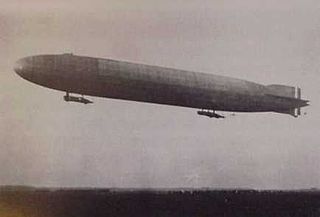
A Zeppelin is a type of rigid airship named after the German Count Ferdinand von Zeppelin who pioneered rigid airship development at the beginning of the 20th century. Zeppelin's notions were first formulated in 1874 and developed in detail in 1893. They were patented in Germany in 1895 and in the United States in 1899. After the outstanding success of the Zeppelin design, the word zeppelin came to be commonly used to refer to all rigid airships. Zeppelins were first flown commercially in 1910 by Deutsche Luftschiffahrts-AG (DELAG), the world's first airline in revenue service. By mid-1914, DELAG had carried over 10,000 fare-paying passengers on over 1,500 flights. During World War I, the German military made extensive use of Zeppelins as bombers and scouts, killing over 500 people in bombing raids in Britain.

The Air Ministry was a department of the Government of the United Kingdom with the responsibility of managing the affairs of the Royal Air Force, that existed from 1918 to 1964. It was under the political authority of the Secretary of State for Air.

A blimp, or non-rigid airship, is an airship (dirigible) or barrage balloon without an internal structural framework or a keel. Unlike semi-rigid and rigid airships, blimps rely on the pressure of the lifting gas inside the envelope and the strength of the envelope itself to maintain their shape.

The Royal Naval Air Service (RNAS) was the air arm of the Royal Navy, under the direction of the Admiralty's Air Department, and existed formally from 1 July 1914 to 1 April 1918, when it was merged with the British Army's Royal Flying Corps to form the Royal Air Force, the world's first independent air force.
This is a list of aviation-related events from 1924:

This is a list of aviation-related events from 1915:
This is a list of aviation-related events from 1916:
This is a list of aviation-related events from 1917:

Air Commodore Edward Maitland Maitland, was an early military aviator who served in the Air Battalion of the Royal Engineers, the Royal Flying Corps, the Royal Naval Air Service and the Royal Air Force. He was a noted pioneer of lighter-than-air aviation.
The best-known German strategic bombing campaign during World War I was the campaign against England, although strategic bombing raids were carried out or attempted on other fronts. The main campaign against England started in January 1915 using airships. From then until the end of World War I the German Navy and Army Luftstreitkräfte mounted over 50 bombing raids on the United Kingdom. These were generally referred to as "Zeppelin raids": although both Zeppelin and Schütte-Lanz airships were used, the Zeppelin company was much better known and was responsible for producing the majority of the airships used. Weather conditions and night flying conditions made airship navigation and maintaining bombing accuracy difficult. Bombs were often dropped miles off target and accurate targeting of military installations was impossible. The civilian casualties made the Zeppelins an object of hatred, and they were dubbed "baby-killers". With the development of effective defensive measures the airship raids became increasingly hazardous, and in 1917 the airships were largely replaced by aeroplanes.

The Astra-Torres airships were non-rigid airships built by Société Astra to a design by Spaniard Leonardo Torres Quevedo in France between about 1908 and 1922. They had a highly-characteristic tri-lobed cross-section rather than the more usual circular cross-section. This was the result of moving most of the blimp's bracing wires inside the envelope in an attempt to minimise drag. Early Astra-Torres airships could be trimmed by moving the entire gondola fore-and-aft.

British Army Dirigible No 1, christened Nulli Secundus was a Semi-rigid airship. First flown on 10 September 1907, it was Britain's first powered military aircraft.

SSclass airships were simple, cheap and easily assembled small non-rigid airships or "blimps" that were developed as a matter of some urgency to counter the German U-boat threat to British shipping during World War I. A secondary purpose was to detect and destroy mines. The class proved to be versatile and effective, with a total of 158 being built in several versions.
The SST class of non-rigid airship or "blimp" was developed in Great Britain during World War I from the earlier SS class airship. The main role of these craft was to escort convoys and scout or search for German U-Boats. A secondary purpose was to detect and destroy mines.

Zeppelin LZ 54, given the military tactical designation L 19, was a World War I Zeppelin of the Kaiserliche Marine. While returning from her first bombing raid on the United Kingdom in early 1916, she came down in the North Sea. Her crew survived the crash, but drowned after the crew of a British fishing vessel refused to rescue them; at the time this was a widely reported and notorious incident.

An air force, also known in some countries as an aerospace force or air army, is in the broadest sense, the national military branch that primarily conducts aerial warfare. More specifically, it is the branch of a nation's armed services that is responsible for aerial warfare as distinct from an army or navy. Typically, air forces are responsible for gaining control of the air, carrying out strategic and tactical bombing missions, and providing support to land and naval forces often in the form of aerial reconnaissance and close air support.
The Epsilon class blimp was a proposed British airship designed for the British Army in the 1910s.
The Eta airship was a British airship built for the British Army and later the Royal Navy.














